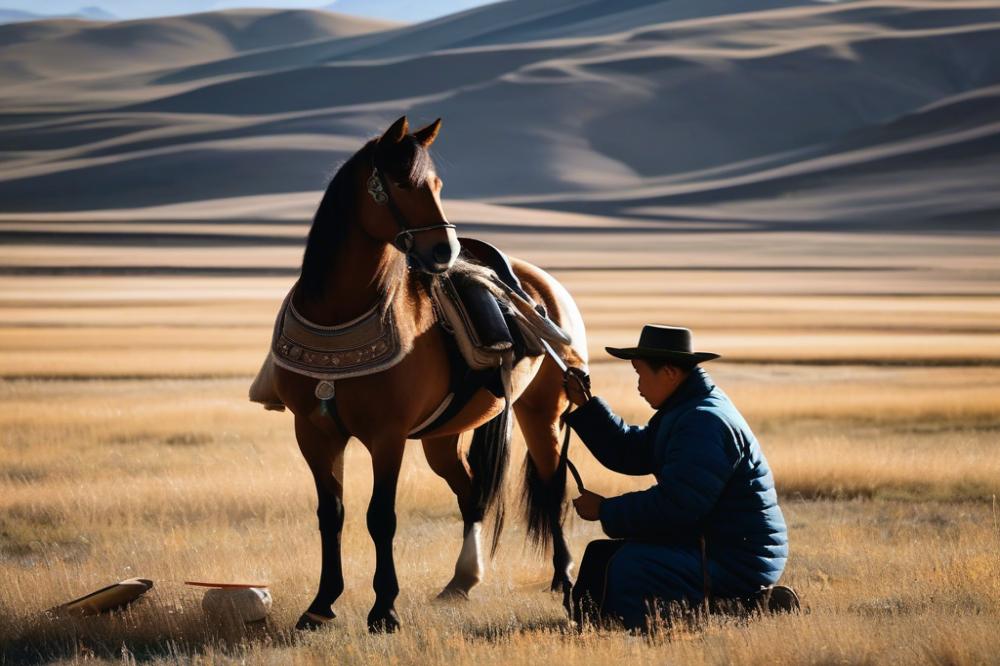Introduction
Mongolia’s herding culture is deeply intertwined with the land and its animals. nomadic herders rely on horses for various aspects of their daily lives. These animals serve as transportation, companions, and even a source of income. The relationship between herders and their steeds goes beyond simple utility; it is a bond built over generations.
Horses hold a vital role in sustaining the traditions of Mongolian life. They embody freedom on the vast steppes. For families that move with the seasons, a healthy horse is crucial. The wellbeing of these animals directly impacts the herders’ ability to thrive in a challenging environment. Therefore, horse hoof care becomes an essential practice. When hooves are neglected, horses can suffer serious health issues.
Traditional methods of maintaining hoof health have been passed down through the ages. Herders often rely on their knowledge and observations to guide their practices. They know the importance of inspecting each hoof after long rides or when grazing in rocky terrain. Simple tools are often used, alongside techniques rooted in time-honored wisdom. These methods highlight a commitment to the animals and a respect for their needs.
In this article, we will explore how nomadic herders maintain their mounts. We will delve into their techniques for ensuring horse health while keeping traditions alive. Through their practices, we can see the careful balance of culture and care that defines life in Mongolia.
The Importance of horse hoof care

The health of a horse’s hooves is essential for its overall well-being. Good hoof condition allows a horse to perform at its best. Bad hooves can lead to pain, injury, or even lameness. In Mongolia’s rugged landscape, proper hoof maintenance becomes even more critical. Without adequate care, horses struggle to navigate the rocky terrain and challenging conditions that nomadic herders face.
Understanding hoof health and Its Impact on Horse Performance
Each horse relies on its hooves to support its body weight and movements. Hoof issues can hinder performance and affect stamina. A horse with sore or damaged hooves may avoid certain activities, which can limit its usefulness to herders. Respecting hoof health contributes greatly to a horse’s physical fitness. Regular checks can help herders recognize problems early.
Common Hoof Problems Faced by Horses in the Mongolian Terrain
Mongolia’s diverse terrain presents several challenges for horse hooves. For instance, the hard, unforgiving ground can cause cracks and chips. Horses may also face conditions like thrush, a bacterial infection that affects the hoof. Weather extremes complicate hoof care too. Wet, muddy conditions can soften hooves and make them vulnerable to injury. Understanding these issues helps herders in maintaining their mounts effectively.
The Role of Hoof Care in Preventing Injuries and Ensuring Longevity
Proper care plays a significant role in preventing injuries. Regular trimming keeps hooves balanced and reduces the risk of fractures. Cleaning hooves removes stones or dirt that could lead to discomfort or infection. Herders pay close attention to their horses, detecting signs of trouble early. This vigilance supports the horse’s longevity, ensuring they remain strong and healthy for years. A well-cared hoof allows a horse to thrive in the demanding conditions of nomadic life.
Traditional Methods of Hoof Care

Nomadic herders in Mongolia have their own ways of caring for the hooves of their horses. These methods are not only practical but also rooted in generations of knowledge. Herders often rely on simple tools that have been used for years. A sharp knife is a common choice for trimming. This tool allows them to carefully remove excess hoof material.
Regular hoof maintenance is essential, especially before seasonal changes. In spring, herders check their horses’ hooves after a long winter. The harsh conditions can lead to cracks or other issues. By trimming the hooves, herders help promote healthy growth. It’s a necessary task that keeps horses moving comfortably across the rugged terrain.
In summer, care shifts slightly. Many herders practice preventative skills, as horses may travel long distances for grazing. Checking hooves becomes a daily routine, as performance can decline with bad care. Herders often look for stones or other debris stuck in hoof cracks. Removing such obstacles prevents infections and ensures the horses remain sound.
Traditional practices also include the use of natural remedies. For instance, some herders apply lubricants made from natural oils to keep hooves hydrated. These solutions emphasize the importance of balance in hoof care. Herders believe that a well-maintained hoof can withstand the demands of the environment. They understand how uneven surfaces can affect a horse’s overall health.
In the fall, herders prepare for the onset of winter. Horses need extra attention as colder temperatures approach. This time of year often involves trimming more frequently. Maintaining hoof health becomes crucial for the horses to navigate through snow and ice later on. Adjustments in care during seasonal transitions reflect a deep understanding of animal needs.
With each season bringing its own challenges, nomadic herders adapt their hoof care techniques. These adjustments reveal a connection to their environment and resources. By following these traditional methods, herders keep their horses healthy and strong, ready for any journey ahead.
Natural Remedies and Modern Practices
Overview of natural remedies used in hoof care
Mongolian nomadic herders have long relied on natural remedies to care for their horses’ hooves. Ingredients for these remedies are often sourced from the local environment. Common practices include using herbal poultices made from plants like sage or thyme. These plants are believed to have antibacterial properties and can help soothe injuries. Another useful treatment involves mud, which is thought to draw out infections or soothe soreness. Herders also use a mixture of animal fats and oils as moisturizers to keep hooves healthy. These time-tested methods demonstrate a strong connection to nature and tradition.
Transition of some herders to modern hoof care techniques
In recent years, some herders have begun adopting modern hoof care techniques. Access to veterinary services and information through mobile technology encourages this change. Specialized shoes and hoof trimming tools are becoming more common among progressive herders. Some now consult farriers and veterinarians to ensure that their horses receive expert care. These advancements can drastically improve hoof health and performance, especially for working horses.
Balancing tradition with contemporary practices in equine care
Striking a balance between traditional remedies and modern practices is not always easy. Many herders appreciate the wisdom of past generations but also understand the benefits of modernization. Incorporating new methods does not mean abandoning traditional knowledge. Instead, it offers a way to enhance horse wellness while respecting cultural heritage. New techniques can serve as tools to reinforce the age-old wisdom that has guided them for centuries. This blend of old and new reflects a thoughtful approach to caring for their treasured mounts.
Challenges in Maintaining Hoof Health
Environmental Factors Affecting Hoof Health in Mongolia
Mongolia’s landscape poses significant challenges for horses. Vast steppes, varied terrain, and extreme weather contribute greatly to hoof-related issues. During summer, sharp rocks and rough ground can wear down hooves faster than normal. In winter, snow and ice create slippery surfaces that can lead to injuries. Additionally, the lack of vegetation can mean that horses do not get the necessary nutrients to support healthy hooves.
Weather plays a big role. During the rainy season, muddy conditions can cause hooves to soften. Wet hooves are more prone to problems like thrush and other infections. Dry spells have their own set of troubles, as hard ground can lead to cracking and bruising. Each season brings its own set of challenges for nomadic herders.
Economic and Logistical Challenges Faced by Nomadic Herders
Resources can be limited in remote areas. Many herders struggle to find tools and materials necessary for proper hoof care. Far from cities, they often do not have access to veterinary services or farriers. This situation makes it tough to address hoof problems effectively. Time is another constraint. With numerous responsibilities like managing livestock and moving to new pastures, herders may find it hard to dedicate sufficient time to each horse’s needs.
Economic conditions are also a factor. Many rely on their horses for survival and income, meaning that improper care can lead to further economic hardship. If a horse becomes lame or injured, the herder faces significant setbacks. The cost of travel to find help can be prohibitive, forcing many to rely on their limited knowledge instead of professional assistance.
Strategies Employed to Overcome These Challenges
Herders often employ traditional methods passed down through generations. Care routines may include regular examinations of hooves to look for any signs of trouble. When conditions allow, they practice trimming hooves to manage wear. Some build makeshift tools from local materials to aid in hoof care.
Community knowledge plays a vital role. Sharing techniques with other herders helps improve overall care standards. Many nomadic families also work together to support one another, especially during challenging seasons. When one horse needs attention, neighbors often lend a hand.
Education remains crucial. Workshops on hoof care organized by NGOs or local groups can provide valuable insights. Herders who understand preventative measures are better equipped to keep their horses healthy. Ultimately, the passion for their animals drives nomadic herders to find solutions despite the obstacles they face.
Wrapping It Up
The Importance of Hoof Care in Mongolian Culture
Caring for a horse’s hooves holds great significance within the sphere of Mongolian herding. These animals are not just modes of transportation; they represent a way of life. Their well-being is closely tied to the success of herding seasons. Healthy hooves directly impact the horse’s performance in herding livestock and navigating the rugged landscapes. After all, a horse is crucial for nomadic families, often becoming both a trusted partner and a symbol of cultural heritage.
Looking Ahead: The Future of Hoof Care
Thoughts on hoof health practices may shift in the coming years. Many herders face challenges from modern influences, like new technologies and changing environments. Blending traditional methods with contemporary veterinary practices could improve outcomes for both horses and herders. It’s essential for the next generation to learn and adapt. This blend of old and new could foster a stronger focus on maintaining equine wellness, which many nomadic families may appreciate even more.
Encouraging Support for Equine Wellness
Support for the health of horses in Mongolia is crucial. Communities can come together to promote knowledge sharing about hoof care. Understanding the cultural importance of these practices can lead to greater appreciation. People can also advocate for resources that help herders maintain their horses’ health through seasons of change. Together, these efforts can create a brighter future for both horses and the nomadic lifestyle they support.



